Shape Memory Alloy Report: Properties, Applications, and Research Gaps
VerifiedAdded on 2023/01/18
|7
|1614
|95
Report
AI Summary
This report provides a comprehensive overview of shape memory alloys (SMAs), focusing on their unique properties and diverse applications. The introduction highlights the temperature-dependent characteristics of SMAs, particularly Nitinol, and its biocompatibility, making it suitable for biomedical applications. The report delves into the two main phases of SMAs: high and low-temperature phases, emphasizing the significance of martensitic transformation, superelasticity, and the shape memory effect. It explores various applications, including cardiovascular devices and orthopedic implants. The report also examines the properties of SMAs, including martensitic transformation and shape memory effects, and discusses the use of SMA materials in applications like bridge stay cables and helical springs. The report concludes by identifying research gaps, specifically the need for a better understanding of the thermochemical behavior of SMA springs under thermo-mechanical loads. The report references numerous studies to support its claims, providing a solid foundation for understanding the current state and future research directions of SMAs.

SHAPE MEMORY ALLOY
By Name
Course
Instructor
Institution
Location
Date
By Name
Course
Instructor
Institution
Location
Date
Paraphrase This Document
Need a fresh take? Get an instant paraphrase of this document with our AI Paraphraser
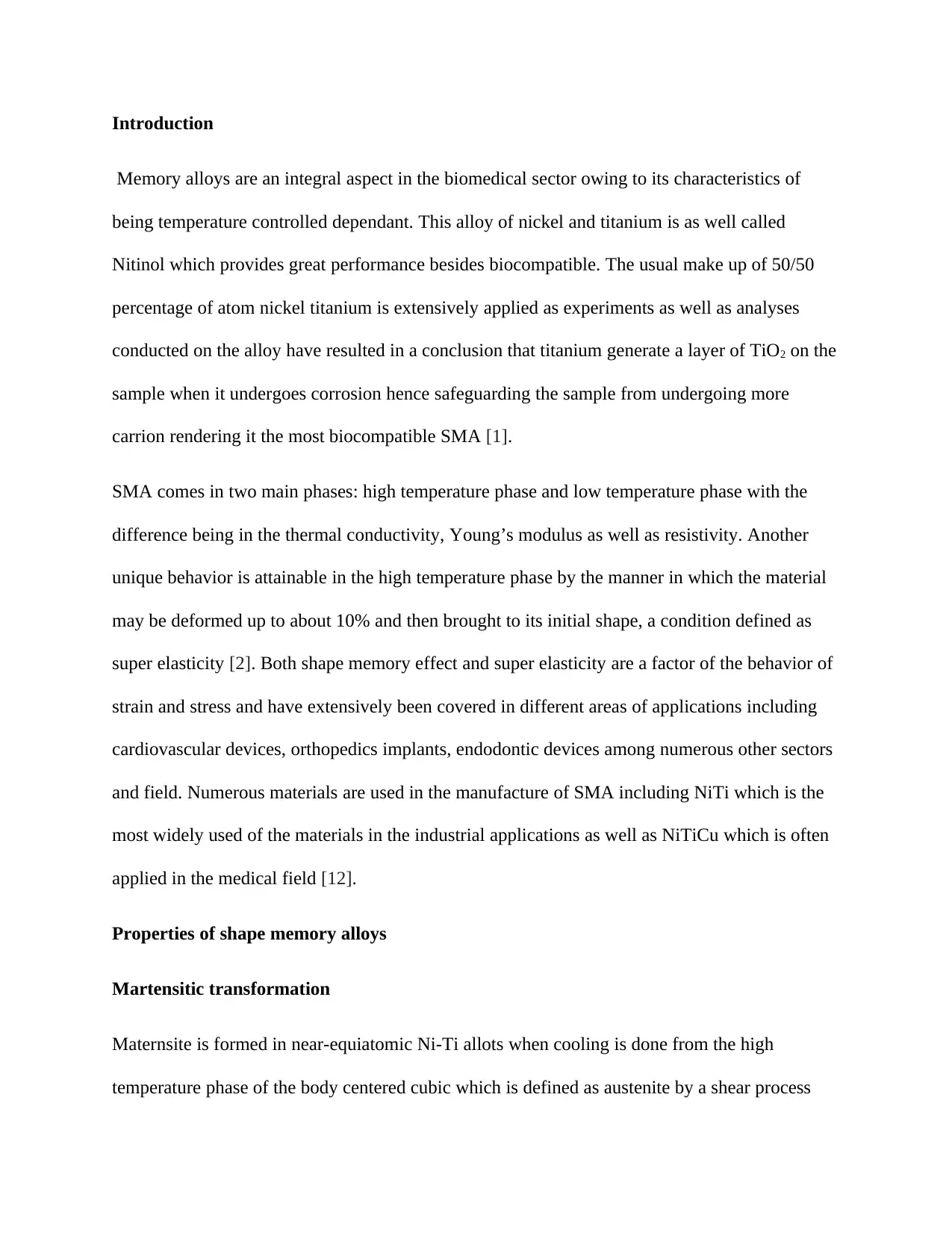
Introduction
Memory alloys are an integral aspect in the biomedical sector owing to its characteristics of
being temperature controlled dependant. This alloy of nickel and titanium is as well called
Nitinol which provides great performance besides biocompatible. The usual make up of 50/50
percentage of atom nickel titanium is extensively applied as experiments as well as analyses
conducted on the alloy have resulted in a conclusion that titanium generate a layer of TiO2 on the
sample when it undergoes corrosion hence safeguarding the sample from undergoing more
carrion rendering it the most biocompatible SMA [1].
SMA comes in two main phases: high temperature phase and low temperature phase with the
difference being in the thermal conductivity, Young’s modulus as well as resistivity. Another
unique behavior is attainable in the high temperature phase by the manner in which the material
may be deformed up to about 10% and then brought to its initial shape, a condition defined as
super elasticity [2]. Both shape memory effect and super elasticity are a factor of the behavior of
strain and stress and have extensively been covered in different areas of applications including
cardiovascular devices, orthopedics implants, endodontic devices among numerous other sectors
and field. Numerous materials are used in the manufacture of SMA including NiTi which is the
most widely used of the materials in the industrial applications as well as NiTiCu which is often
applied in the medical field [12].
Properties of shape memory alloys
Martensitic transformation
Maternsite is formed in near-equiatomic Ni-Ti allots when cooling is done from the high
temperature phase of the body centered cubic which is defined as austenite by a shear process
Memory alloys are an integral aspect in the biomedical sector owing to its characteristics of
being temperature controlled dependant. This alloy of nickel and titanium is as well called
Nitinol which provides great performance besides biocompatible. The usual make up of 50/50
percentage of atom nickel titanium is extensively applied as experiments as well as analyses
conducted on the alloy have resulted in a conclusion that titanium generate a layer of TiO2 on the
sample when it undergoes corrosion hence safeguarding the sample from undergoing more
carrion rendering it the most biocompatible SMA [1].
SMA comes in two main phases: high temperature phase and low temperature phase with the
difference being in the thermal conductivity, Young’s modulus as well as resistivity. Another
unique behavior is attainable in the high temperature phase by the manner in which the material
may be deformed up to about 10% and then brought to its initial shape, a condition defined as
super elasticity [2]. Both shape memory effect and super elasticity are a factor of the behavior of
strain and stress and have extensively been covered in different areas of applications including
cardiovascular devices, orthopedics implants, endodontic devices among numerous other sectors
and field. Numerous materials are used in the manufacture of SMA including NiTi which is the
most widely used of the materials in the industrial applications as well as NiTiCu which is often
applied in the medical field [12].
Properties of shape memory alloys
Martensitic transformation
Maternsite is formed in near-equiatomic Ni-Ti allots when cooling is done from the high
temperature phase of the body centered cubic which is defined as austenite by a shear process
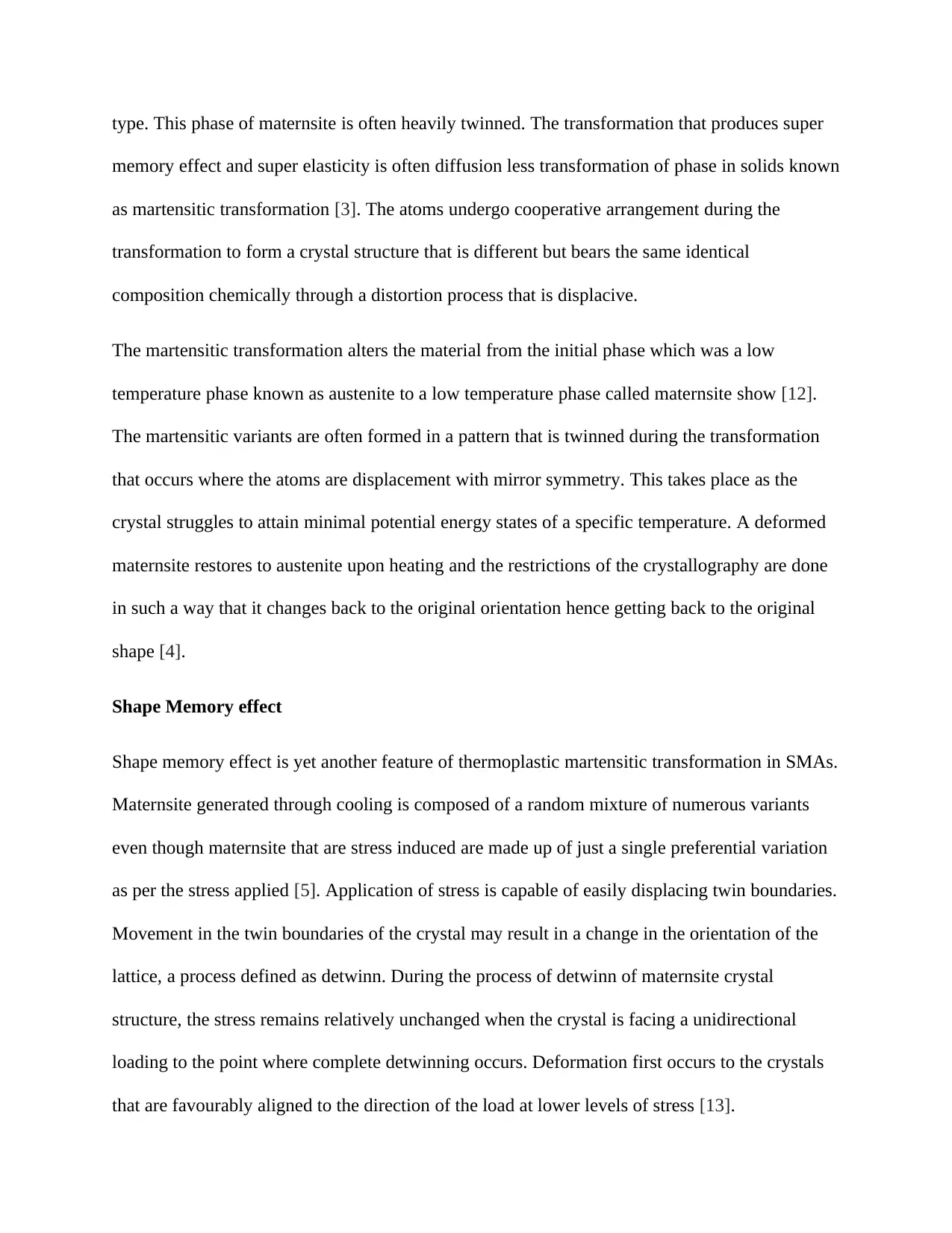
type. This phase of maternsite is often heavily twinned. The transformation that produces super
memory effect and super elasticity is often diffusion less transformation of phase in solids known
as martensitic transformation [3]. The atoms undergo cooperative arrangement during the
transformation to form a crystal structure that is different but bears the same identical
composition chemically through a distortion process that is displacive.
The martensitic transformation alters the material from the initial phase which was a low
temperature phase known as austenite to a low temperature phase called maternsite show [12].
The martensitic variants are often formed in a pattern that is twinned during the transformation
that occurs where the atoms are displacement with mirror symmetry. This takes place as the
crystal struggles to attain minimal potential energy states of a specific temperature. A deformed
maternsite restores to austenite upon heating and the restrictions of the crystallography are done
in such a way that it changes back to the original orientation hence getting back to the original
shape [4].
Shape Memory effect
Shape memory effect is yet another feature of thermoplastic martensitic transformation in SMAs.
Maternsite generated through cooling is composed of a random mixture of numerous variants
even though maternsite that are stress induced are made up of just a single preferential variation
as per the stress applied [5]. Application of stress is capable of easily displacing twin boundaries.
Movement in the twin boundaries of the crystal may result in a change in the orientation of the
lattice, a process defined as detwinn. During the process of detwinn of maternsite crystal
structure, the stress remains relatively unchanged when the crystal is facing a unidirectional
loading to the point where complete detwinning occurs. Deformation first occurs to the crystals
that are favourably aligned to the direction of the load at lower levels of stress [13].
memory effect and super elasticity is often diffusion less transformation of phase in solids known
as martensitic transformation [3]. The atoms undergo cooperative arrangement during the
transformation to form a crystal structure that is different but bears the same identical
composition chemically through a distortion process that is displacive.
The martensitic transformation alters the material from the initial phase which was a low
temperature phase known as austenite to a low temperature phase called maternsite show [12].
The martensitic variants are often formed in a pattern that is twinned during the transformation
that occurs where the atoms are displacement with mirror symmetry. This takes place as the
crystal struggles to attain minimal potential energy states of a specific temperature. A deformed
maternsite restores to austenite upon heating and the restrictions of the crystallography are done
in such a way that it changes back to the original orientation hence getting back to the original
shape [4].
Shape Memory effect
Shape memory effect is yet another feature of thermoplastic martensitic transformation in SMAs.
Maternsite generated through cooling is composed of a random mixture of numerous variants
even though maternsite that are stress induced are made up of just a single preferential variation
as per the stress applied [5]. Application of stress is capable of easily displacing twin boundaries.
Movement in the twin boundaries of the crystal may result in a change in the orientation of the
lattice, a process defined as detwinn. During the process of detwinn of maternsite crystal
structure, the stress remains relatively unchanged when the crystal is facing a unidirectional
loading to the point where complete detwinning occurs. Deformation first occurs to the crystals
that are favourably aligned to the direction of the load at lower levels of stress [13].
⊘ This is a preview!⊘
Do you want full access?
Subscribe today to unlock all pages.

Trusted by 1+ million students worldwide
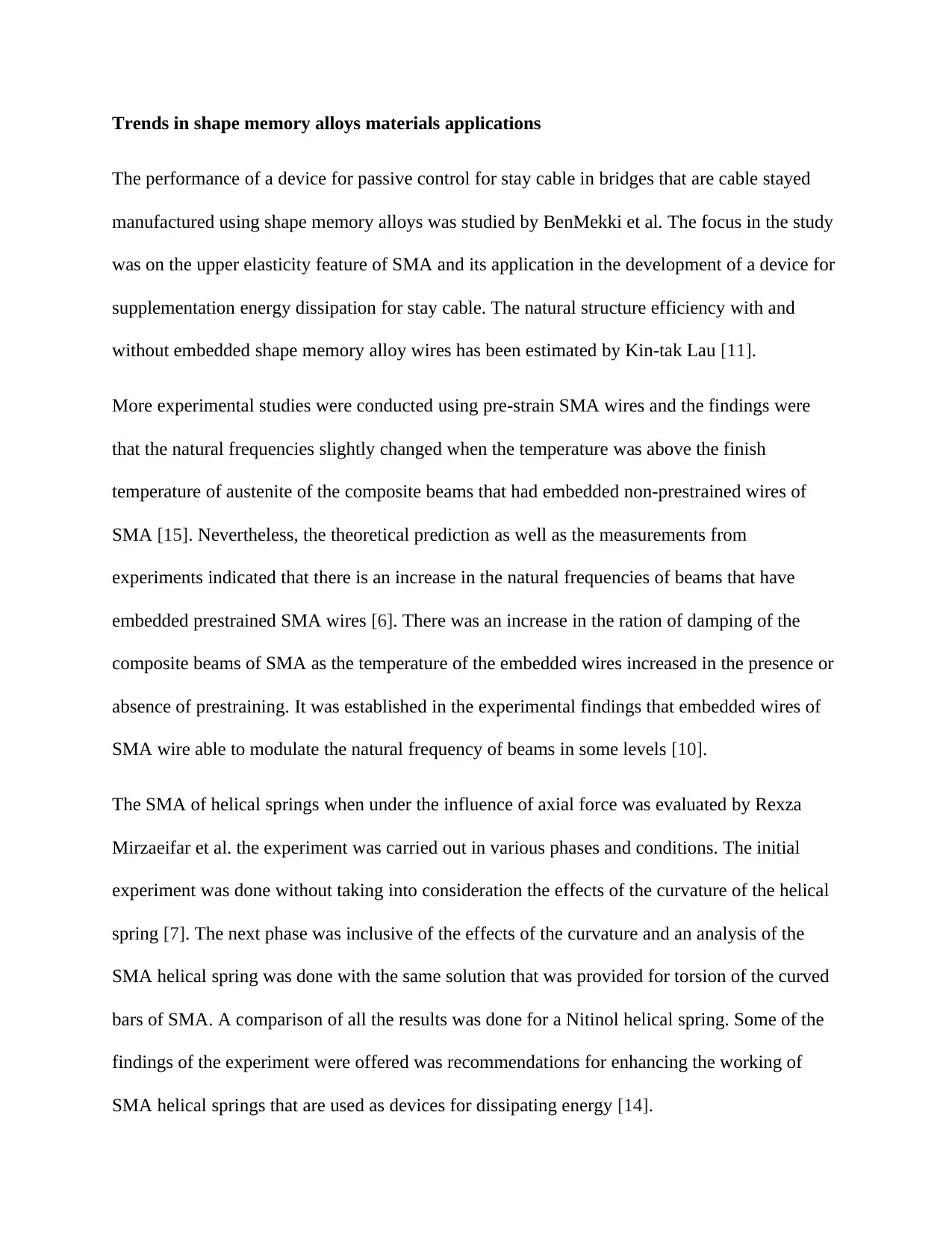
Trends in shape memory alloys materials applications
The performance of a device for passive control for stay cable in bridges that are cable stayed
manufactured using shape memory alloys was studied by BenMekki et al. The focus in the study
was on the upper elasticity feature of SMA and its application in the development of a device for
supplementation energy dissipation for stay cable. The natural structure efficiency with and
without embedded shape memory alloy wires has been estimated by Kin-tak Lau [11].
More experimental studies were conducted using pre-strain SMA wires and the findings were
that the natural frequencies slightly changed when the temperature was above the finish
temperature of austenite of the composite beams that had embedded non-prestrained wires of
SMA [15]. Nevertheless, the theoretical prediction as well as the measurements from
experiments indicated that there is an increase in the natural frequencies of beams that have
embedded prestrained SMA wires [6]. There was an increase in the ration of damping of the
composite beams of SMA as the temperature of the embedded wires increased in the presence or
absence of prestraining. It was established in the experimental findings that embedded wires of
SMA wire able to modulate the natural frequency of beams in some levels [10].
The SMA of helical springs when under the influence of axial force was evaluated by Rexza
Mirzaeifar et al. the experiment was carried out in various phases and conditions. The initial
experiment was done without taking into consideration the effects of the curvature of the helical
spring [7]. The next phase was inclusive of the effects of the curvature and an analysis of the
SMA helical spring was done with the same solution that was provided for torsion of the curved
bars of SMA. A comparison of all the results was done for a Nitinol helical spring. Some of the
findings of the experiment were offered was recommendations for enhancing the working of
SMA helical springs that are used as devices for dissipating energy [14].
The performance of a device for passive control for stay cable in bridges that are cable stayed
manufactured using shape memory alloys was studied by BenMekki et al. The focus in the study
was on the upper elasticity feature of SMA and its application in the development of a device for
supplementation energy dissipation for stay cable. The natural structure efficiency with and
without embedded shape memory alloy wires has been estimated by Kin-tak Lau [11].
More experimental studies were conducted using pre-strain SMA wires and the findings were
that the natural frequencies slightly changed when the temperature was above the finish
temperature of austenite of the composite beams that had embedded non-prestrained wires of
SMA [15]. Nevertheless, the theoretical prediction as well as the measurements from
experiments indicated that there is an increase in the natural frequencies of beams that have
embedded prestrained SMA wires [6]. There was an increase in the ration of damping of the
composite beams of SMA as the temperature of the embedded wires increased in the presence or
absence of prestraining. It was established in the experimental findings that embedded wires of
SMA wire able to modulate the natural frequency of beams in some levels [10].
The SMA of helical springs when under the influence of axial force was evaluated by Rexza
Mirzaeifar et al. the experiment was carried out in various phases and conditions. The initial
experiment was done without taking into consideration the effects of the curvature of the helical
spring [7]. The next phase was inclusive of the effects of the curvature and an analysis of the
SMA helical spring was done with the same solution that was provided for torsion of the curved
bars of SMA. A comparison of all the results was done for a Nitinol helical spring. Some of the
findings of the experiment were offered was recommendations for enhancing the working of
SMA helical springs that are used as devices for dissipating energy [14].
Paraphrase This Document
Need a fresh take? Get an instant paraphrase of this document with our AI Paraphraser
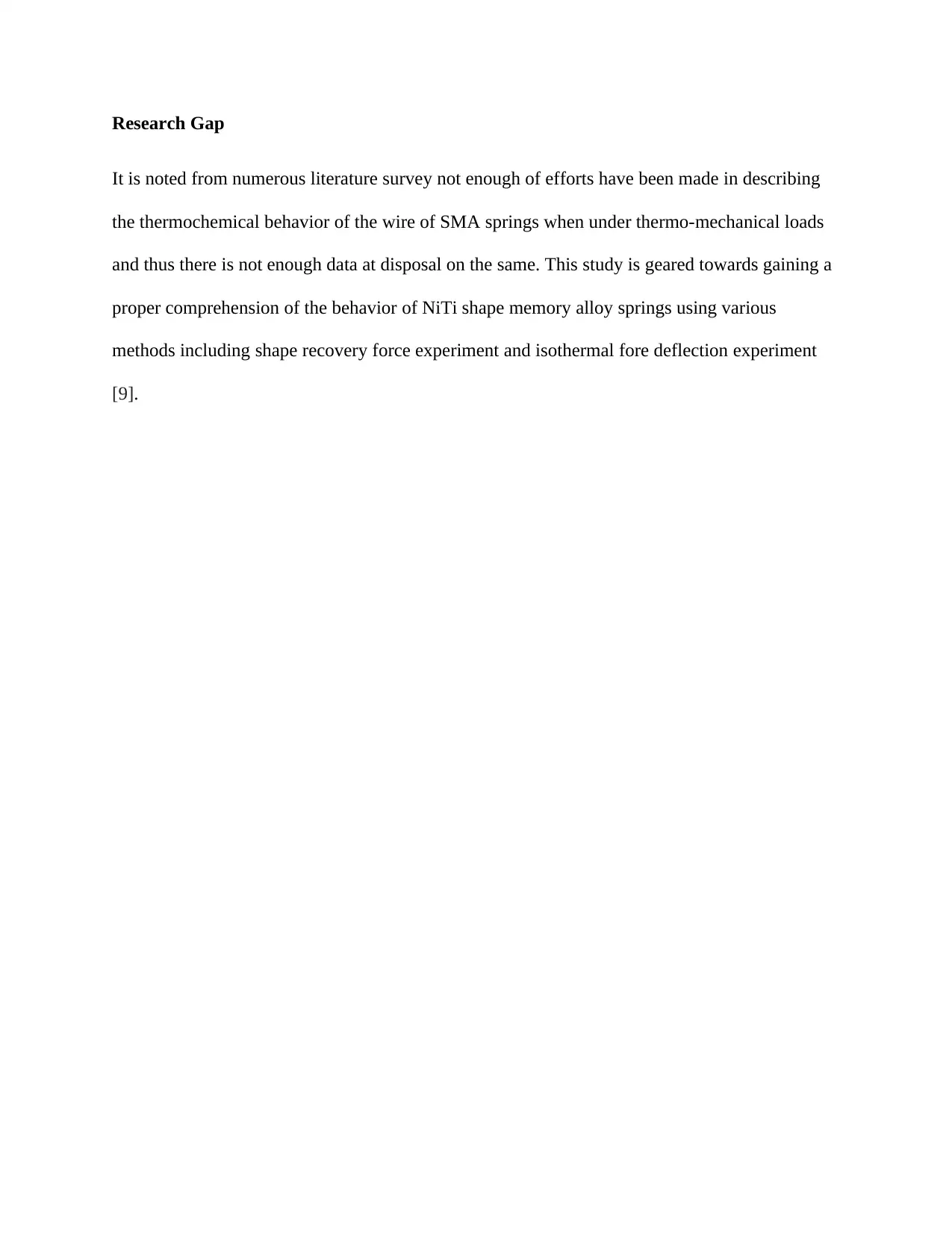
Research Gap
It is noted from numerous literature survey not enough of efforts have been made in describing
the thermochemical behavior of the wire of SMA springs when under thermo-mechanical loads
and thus there is not enough data at disposal on the same. This study is geared towards gaining a
proper comprehension of the behavior of NiTi shape memory alloy springs using various
methods including shape recovery force experiment and isothermal fore deflection experiment
[9].
It is noted from numerous literature survey not enough of efforts have been made in describing
the thermochemical behavior of the wire of SMA springs when under thermo-mechanical loads
and thus there is not enough data at disposal on the same. This study is geared towards gaining a
proper comprehension of the behavior of NiTi shape memory alloy springs using various
methods including shape recovery force experiment and isothermal fore deflection experiment
[9].
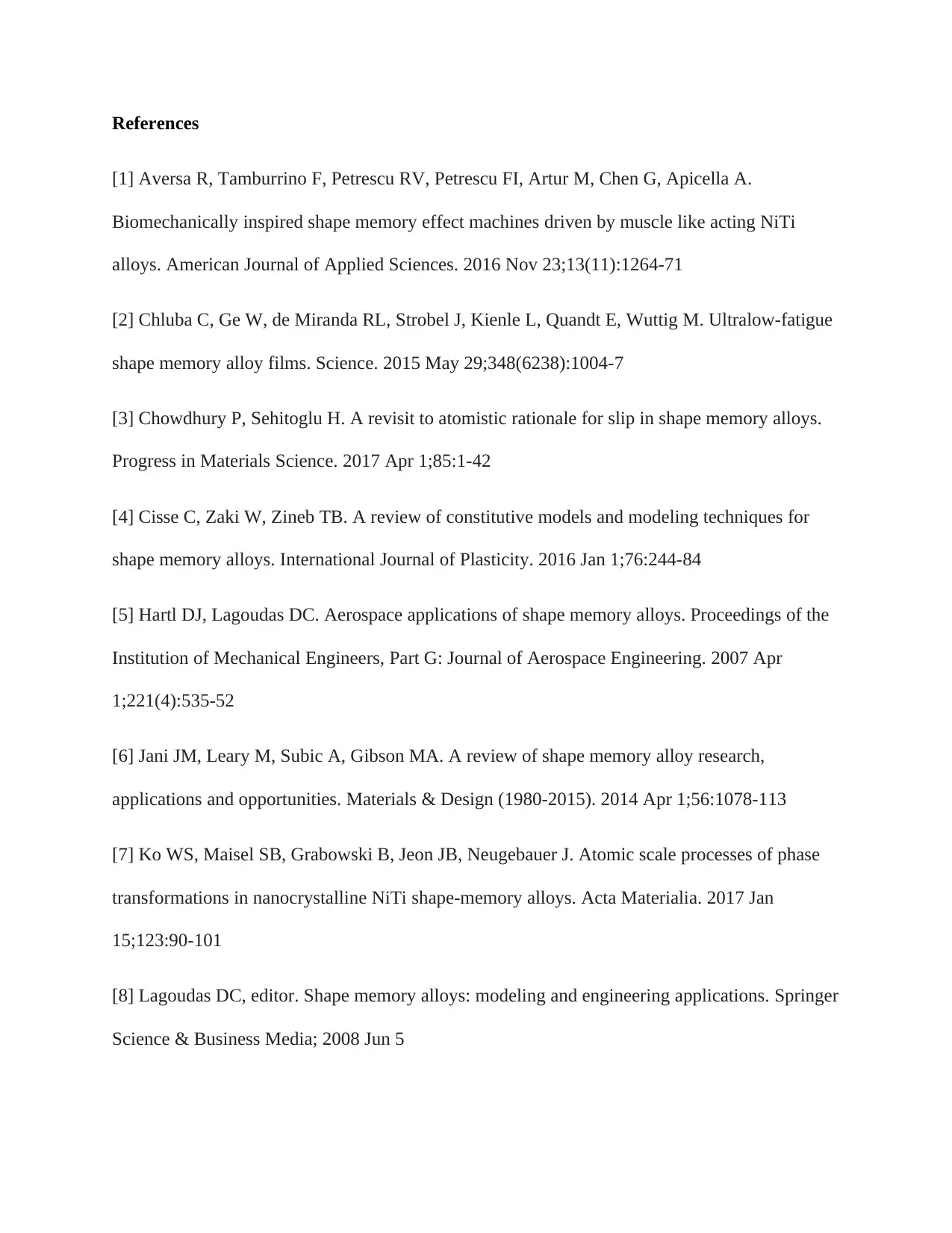
References
[1] Aversa R, Tamburrino F, Petrescu RV, Petrescu FI, Artur M, Chen G, Apicella A.
Biomechanically inspired shape memory effect machines driven by muscle like acting NiTi
alloys. American Journal of Applied Sciences. 2016 Nov 23;13(11):1264-71
[2] Chluba C, Ge W, de Miranda RL, Strobel J, Kienle L, Quandt E, Wuttig M. Ultralow-fatigue
shape memory alloy films. Science. 2015 May 29;348(6238):1004-7
[3] Chowdhury P, Sehitoglu H. A revisit to atomistic rationale for slip in shape memory alloys.
Progress in Materials Science. 2017 Apr 1;85:1-42
[4] Cisse C, Zaki W, Zineb TB. A review of constitutive models and modeling techniques for
shape memory alloys. International Journal of Plasticity. 2016 Jan 1;76:244-84
[5] Hartl DJ, Lagoudas DC. Aerospace applications of shape memory alloys. Proceedings of the
Institution of Mechanical Engineers, Part G: Journal of Aerospace Engineering. 2007 Apr
1;221(4):535-52
[6] Jani JM, Leary M, Subic A, Gibson MA. A review of shape memory alloy research,
applications and opportunities. Materials & Design (1980-2015). 2014 Apr 1;56:1078-113
[7] Ko WS, Maisel SB, Grabowski B, Jeon JB, Neugebauer J. Atomic scale processes of phase
transformations in nanocrystalline NiTi shape-memory alloys. Acta Materialia. 2017 Jan
15;123:90-101
[8] Lagoudas DC, editor. Shape memory alloys: modeling and engineering applications. Springer
Science & Business Media; 2008 Jun 5
[1] Aversa R, Tamburrino F, Petrescu RV, Petrescu FI, Artur M, Chen G, Apicella A.
Biomechanically inspired shape memory effect machines driven by muscle like acting NiTi
alloys. American Journal of Applied Sciences. 2016 Nov 23;13(11):1264-71
[2] Chluba C, Ge W, de Miranda RL, Strobel J, Kienle L, Quandt E, Wuttig M. Ultralow-fatigue
shape memory alloy films. Science. 2015 May 29;348(6238):1004-7
[3] Chowdhury P, Sehitoglu H. A revisit to atomistic rationale for slip in shape memory alloys.
Progress in Materials Science. 2017 Apr 1;85:1-42
[4] Cisse C, Zaki W, Zineb TB. A review of constitutive models and modeling techniques for
shape memory alloys. International Journal of Plasticity. 2016 Jan 1;76:244-84
[5] Hartl DJ, Lagoudas DC. Aerospace applications of shape memory alloys. Proceedings of the
Institution of Mechanical Engineers, Part G: Journal of Aerospace Engineering. 2007 Apr
1;221(4):535-52
[6] Jani JM, Leary M, Subic A, Gibson MA. A review of shape memory alloy research,
applications and opportunities. Materials & Design (1980-2015). 2014 Apr 1;56:1078-113
[7] Ko WS, Maisel SB, Grabowski B, Jeon JB, Neugebauer J. Atomic scale processes of phase
transformations in nanocrystalline NiTi shape-memory alloys. Acta Materialia. 2017 Jan
15;123:90-101
[8] Lagoudas DC, editor. Shape memory alloys: modeling and engineering applications. Springer
Science & Business Media; 2008 Jun 5
⊘ This is a preview!⊘
Do you want full access?
Subscribe today to unlock all pages.

Trusted by 1+ million students worldwide
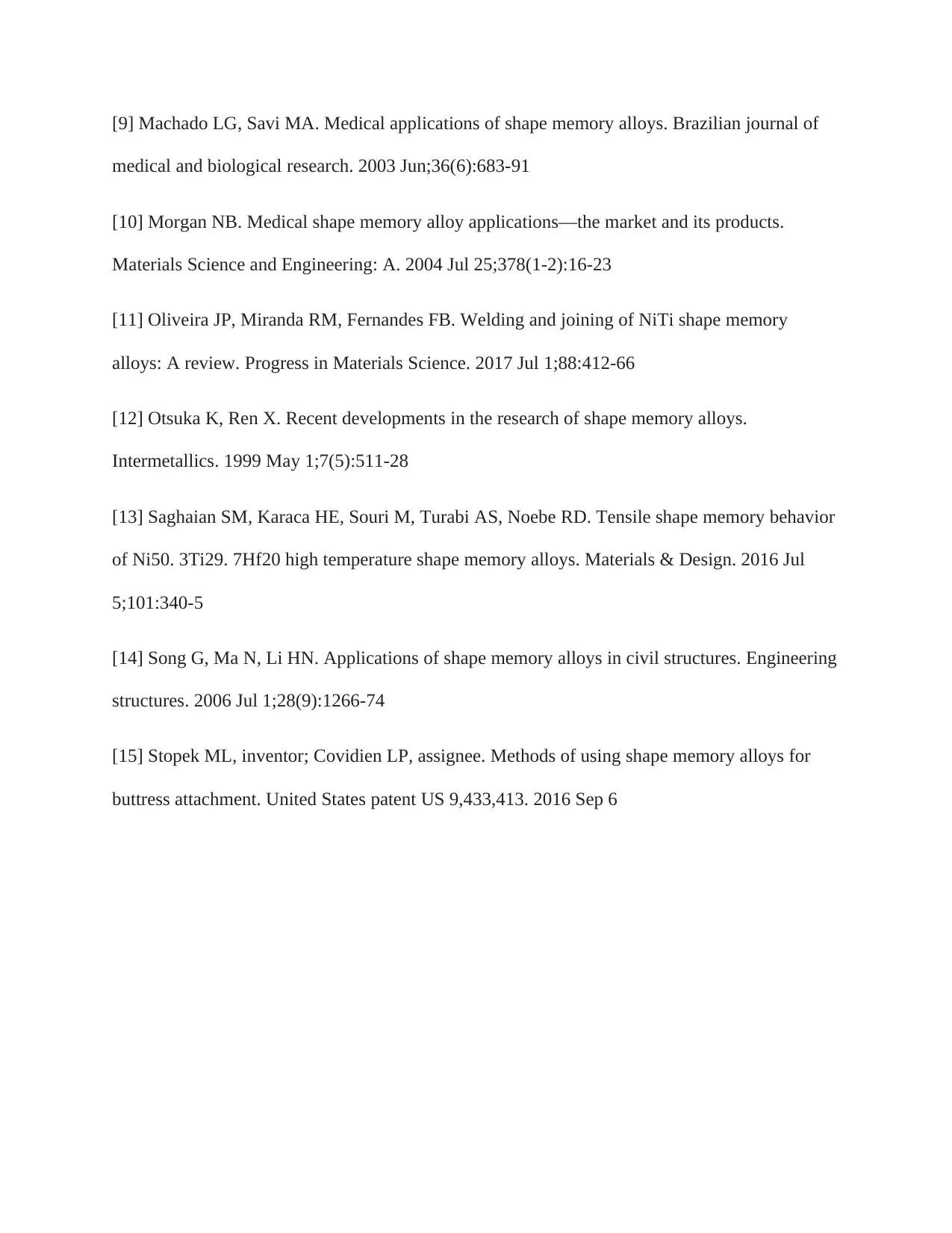
[9] Machado LG, Savi MA. Medical applications of shape memory alloys. Brazilian journal of
medical and biological research. 2003 Jun;36(6):683-91
[10] Morgan NB. Medical shape memory alloy applications—the market and its products.
Materials Science and Engineering: A. 2004 Jul 25;378(1-2):16-23
[11] Oliveira JP, Miranda RM, Fernandes FB. Welding and joining of NiTi shape memory
alloys: A review. Progress in Materials Science. 2017 Jul 1;88:412-66
[12] Otsuka K, Ren X. Recent developments in the research of shape memory alloys.
Intermetallics. 1999 May 1;7(5):511-28
[13] Saghaian SM, Karaca HE, Souri M, Turabi AS, Noebe RD. Tensile shape memory behavior
of Ni50. 3Ti29. 7Hf20 high temperature shape memory alloys. Materials & Design. 2016 Jul
5;101:340-5
[14] Song G, Ma N, Li HN. Applications of shape memory alloys in civil structures. Engineering
structures. 2006 Jul 1;28(9):1266-74
[15] Stopek ML, inventor; Covidien LP, assignee. Methods of using shape memory alloys for
buttress attachment. United States patent US 9,433,413. 2016 Sep 6
medical and biological research. 2003 Jun;36(6):683-91
[10] Morgan NB. Medical shape memory alloy applications—the market and its products.
Materials Science and Engineering: A. 2004 Jul 25;378(1-2):16-23
[11] Oliveira JP, Miranda RM, Fernandes FB. Welding and joining of NiTi shape memory
alloys: A review. Progress in Materials Science. 2017 Jul 1;88:412-66
[12] Otsuka K, Ren X. Recent developments in the research of shape memory alloys.
Intermetallics. 1999 May 1;7(5):511-28
[13] Saghaian SM, Karaca HE, Souri M, Turabi AS, Noebe RD. Tensile shape memory behavior
of Ni50. 3Ti29. 7Hf20 high temperature shape memory alloys. Materials & Design. 2016 Jul
5;101:340-5
[14] Song G, Ma N, Li HN. Applications of shape memory alloys in civil structures. Engineering
structures. 2006 Jul 1;28(9):1266-74
[15] Stopek ML, inventor; Covidien LP, assignee. Methods of using shape memory alloys for
buttress attachment. United States patent US 9,433,413. 2016 Sep 6
1 out of 7
Your All-in-One AI-Powered Toolkit for Academic Success.
+13062052269
info@desklib.com
Available 24*7 on WhatsApp / Email
![[object Object]](/_next/static/media/star-bottom.7253800d.svg)
Unlock your academic potential
Copyright © 2020–2025 A2Z Services. All Rights Reserved. Developed and managed by ZUCOL.

